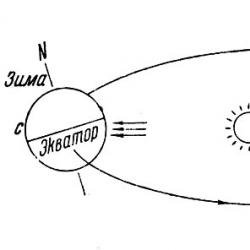Aphelion is the point in the orbit of the celestial body closest to the sun that moves around the sun the most. The Earth passes perihelion The point of the planets' orbit closest to the sun
The Earth, in its annual journey around the Sun, passes perihelion, the point of the Earth's orbit closest to the Sun, from January 2-5. For an observer on Earth, these days the Sun will have its largest apparent diameter in the sky (32’32”), although the difference is almost imperceptible and amounts to approximately 3% between the linear dimensions of the Sun at aphelion and perihelion. The Earth at perihelion is at a distance of 0.983 AU. from the sun.
The Earth makes a full revolution around the central luminary in 365 days 6 hours 9 minutes. 10 sec. The Earth moves around the Sun in an elliptical orbit with an average speed of 29.765 km/sec. The point of the Earth's orbit closest to the Sun is called perihelion and is 147117000 km, the farthest point is aphelion - 152083000 km (1.0167 AU). Due to the fact that the Earth at perihelion is 5 million kilometers closer to the Sun than at aphelion, the apparent size of the solar disk at perihelion is larger than at aphelion. This difference is imperceptible to the eye, because The disc size changes smoothly over six months. Below are two images of the Sun taken for comparison using a telescope and a digital camera on the days of perihelion and aphelion in 2008:
This event does not in any way affect the change of seasons on our home planet. The regular change of seasons is a consequence of the movement of the Earth around the Sun and the inclination of the Earth's axis of rotation to the orbital plane, and not at all due to the changing distance between the Earth and the Sun. This event affects the temperature difference between winter and summer in the northern and southern hemispheres of our planet.
As is known, the flow of energy from the Sun falling on the Earth varies inversely with the square of the distance. The amount of solar energy reaching the Earth is approximately 6.9% greater at perihelion than at aphelion. At perihelion (early January), the southern hemisphere receives slightly more solar energy than the northern. But the vast area of water surface in the southern hemisphere absorbs most of the incoming energy, so seasonal temperature fluctuations are smoother than in the northern hemisphere. Moreover, winters in the northern hemisphere are less severe than in the southern hemisphere, and summers in the northern hemisphere are cooler.
Movement of the Earth around the Sun
With modern parameters of the Earth's orbit, the effect on climate from the tilt of the planet's rotation axis is more significant than the changing distance of the Earth from the Sun. In the northern hemisphere of the Earth, summer begins, when the north pole of the Earth is illuminated by the Sun, and the south pole of the planet is located in its shadow. At the same time, winter begins in the southern hemisphere. When it is spring in the northern hemisphere, it is autumn in the southern hemisphere. When it is autumn in the northern hemisphere, it is spring in the southern hemisphere. The seasons in the southern and northern hemispheres are always opposite. Although the months are named the same, that is, for example, February in the northern hemisphere is the last month of winter and the coldest month; in the south it is the last month of summer, which is also the warmest.
Seasons (for the northern hemisphere)

The exact date of passage of perihelion (it can be found out from the Astronomical calendar) changes from year to year, due to the fact that the line of apses, coinciding with the major axis of the ellipse of the planetary orbit, slowly rotates in the same direction as the Earth itself is moving, and the longitude of perihelion increases by 61.9" per year. The line of apses makes a full revolution in 20934.
Table of the nearest dates of perihelion and aphelion of the Earth (UT+0h)
USNO data
Perihelion Aphelion
Currently, the Earth's perihelion occurs around January 2-5, and aphelion occurs around July 2-5. The speed of the Earth's orbit is not constant: in July it begins to accelerate (after passing aphelion), and in January it begins to slow down again (after passing perihelion).
The average time it takes a sunbeam to reach the Earth is 498.66 seconds. When the Earth is at its farthest point from the Sun (aphelion), this time increases to 506.94 seconds. At the point of the Earth's orbit closest to the Sun (perihelion), this time is reduced to 490.39 seconds.
At what speed does the Earth move in orbit around the Sun?
The Earth moves in its orbit around the sun at an average speed of 29.79 kilometers per second (107,244 kilometers per hour). At perihelion its speed increases to 30.29 kilometers per second (109,044 kilometers per hour), at perihelion it decreases to 29.29 kilometers per second (105,444 kilometers per hour). The Earth travels the length of its diameter in 7 minutes.
In which month is the Earth closest to the Sun and in which month is it farthest from it?
The point of any planet's orbit closest to the Sun is called perihelion, and the farthest point is called aphelion. For the Earth, the distance at perihelion is 147,117,000 kilometers, at aphelion - 152,083,000 kilometers. In the present era, our planet passes through perihelion on January 2–5, and through aphelion on July 1–5. By the way, many are surprised to learn that the Earth is closest to the luminary in January, and farthest from it in July.
Why do the seasons change (winter, spring, summer, autumn)?
Oddly enough, even people with higher education often answer this question incorrectly - most often they refer to the change in the distance from the Earth to the Sun. However, the difference between the distances of our planet to the star at aphelion and perihelion is only about 3 percent and does not have any noticeable effect on the change of seasons. The true reason for the change of seasons on Earth is the inclination of the earth's axis to the plane of the earth's orbit (ecliptic), which is 23 degrees 27 minutes. The sun warms more where the direction of its rays is closer to vertical. The maximum density of energy (heat) received from the Sun occurs in the vicinity of the “subsolar” point on the earth’s surface. And this point, due to the above-mentioned inclination of the earth’s axis to the ecliptic, is located in the Northern Hemisphere from March to September, and in the Southern Hemisphere from September to March.
What are the astronomical seasons and how long are they?
The beginning of the astronomical seasons is taken to be the moments when the center of the Sun passes through the equinoxes and solstices. For modern astronomers, spring does not begin on March 1st. Astronomical spring is the period from the vernal equinox (March 21) to the summer solstice (June 21). Its duration is approximately 92 days 20 hours and 12 minutes. Astronomical summer is the period from the summer solstice (June 21) to the autumn equinox (September 23). Its duration is approximately 93 days 14 hours and 24 minutes. Astronomical autumn lasts from the autumnal equinox (September 23) to the winter solstice (December 22) for 89 days, 18 hours and 42 minutes. Astronomical winter lasts for approximately 89 days and 30 minutes - from the winter solstice (December 22) to the spring equinox (March 21).
What are the celestial poles and where are they located?
Even the ancient Egyptians knew that the starry sky, having completed a circular path in 24 hours, returns to its previous position. And that there is one point in the sky that remains motionless. The axis of rotation of the firmament, or rather the globe, passes through it. Today we call this point the North Pole of the world. It almost coincides with the bright star Alpha Ursa Minor, which is why it is called the North Star. The second (opposite to the North Celestial Pole) point, at which the Earth’s rotation axis intersects with the celestial sphere, is called the South Celestial Pole. There are no bright stars in the immediate vicinity of the South Pole of the world. It is located in the constellation Octant. Without participating in the daily rotation of the celestial sphere, the poles of the world, due to precession, slowly move relative to the stars. Their path lies in circles with a radius of about 23.5 angular degrees with the center at the pole of the ecliptic. They complete a full revolution in 25,770 years. Currently, the North Pole of the world is approaching the North Star. In 2102, the distance between them will be only 27.5 arc minutes, and then the celestial pole will begin to move away from the North Star. After 7,500 years, this name will rightfully be borne by another star - Alderamin (alpha Cephei), and after 13,500 years - Vega (alpha Lyrae). The South Pole of the world is moving accordingly.
What shape does our planet have?
The Earth is not perfectly spherical, but rather flattened at the poles. As a first approximation, it is generally accepted that the true shape of our planet is close to a spheroid - a spatial figure obtained by rotating an ellipse around its minor axis. The equatorial radius of this spheroid is 6378.160 kilometers, and the polar radius is 6356.774 kilometers; their difference is 21.383 kilometers. If you build a model of the Earth with an equatorial diameter of 1 meter, then the polar diameter will be equal to 997 millimeters. More accurate studies have shown that the earth's equator is also not a circle, but an ellipse. Its major axis is 213 meters longer than its minor axis and is directed to a longitude of 7 degrees west of Greenwich.
The most precise geodetic measurements, observations using artificial Earth satellites and gravimetric data have led to a more accurate idea of the shape of the Earth - the geoid (in Greek - earth-like). The geoid is not a regular geometric figure - it is a certain surface, at each point perpendicular to the plumb line (the so-called level surface). It approximately coincides with the tidally undisturbed surface of the oceans, which is mentally extended to the parts of the Earth’s surface occupied by continents (for example, along imaginary channels dug through all the continents from one ocean to another). The heights of various points on Earth are measured from the surface of the geoid when indicating the height above sea level and the depth of the sea. The study of the movement of artificial Earth satellites made it possible to determine that the south pole of the geoid is 30 meters closer to the center than the north.
Perihelion (from Peri... and Greek helios - Sun)
the closest point to the Sun in the orbit of a celestial body moving around the Sun along one of the conic sections - an ellipse, parabola or hyperbola. Due to the action of the disturbing forces of the planets, a change in the position of the planet in space occurs. Near the planet closest to the Sun, Mercury, planetary movement was discovered, occurring in accordance with the refined law of gravity, which follows from the general theory of relativity. P.'s distance from the center of the Sun is called the perihelion distance.
Great Soviet Encyclopedia. - M.: Soviet Encyclopedia. 1969-1978 .
Synonyms:See what "Perihelion" is in other dictionaries:
Perihelion... Spelling dictionary-reference book
The point closest to the sun in the orbit described by a planet or comet. Dictionary of foreign words included in the Russian language. Pavlenkov F., 1907. PERIHELIUM is the point of the path closest to the sun along which. a planet or comet is moving; ... ... Dictionary of foreign words of the Russian language
- (Perihelium, perihelion) see Apses. Samoilov K.I. Marine dictionary. M. L.: State Naval Publishing House of the NKVMF of the USSR, 1941 Perihelion is the point of the orbit of a planet, comet or any other ... Marine Dictionary
- (from peri... and Greek helios Sun) the point of the orbit of a celestial body orbiting around it closest to the Sun. The distance at perihelion between the centers of the Earth and the Sun is 147 million km... Big Encyclopedic Dictionary
PERIHELIUM, the point in the orbit of a celestial body orbiting around it, such as a planet, asteroid, comet or spacecraft, closest to the Sun. see also APHELIUS; APSIDE… Scientific and technical encyclopedic dictionary
PERIHELIUM, perihelion, man. (from Greek peri near and helios sun) (astron.). The point in the orbit of a planet or comet closest to the sun; ant. aphelion. Ushakov's explanatory dictionary. D.N. Ushakov. 1935 1940 ... Ushakov's Explanatory Dictionary
Noun, number of synonyms: 1 point (100) ASIS Dictionary of Synonyms. V.N. Trishin. 2013… Synonym dictionary
perihelion- The point of the orbit of a planet, comet or other celestial body orbiting the Sun closest to the Sun... Dictionary of Geography
I; m. [from Greek. peri around, around and hēlios Sun] Astron. The point in the orbit of a celestial body orbiting around it that is closest to the Sun. * * * perihelion (from peri... and Greek hēlios Sun), the point of the orbit of a celestial body closest to the Sun, ... ... encyclopedic Dictionary
Perihelion- (from the Greek peri around, around, near + helios sun) (in astronomy) the point of the orbit of a celestial body of a planetary system orbiting around it that is closest to the Sun. For example, the perihelion of the Earth is 147 million km... The beginnings of modern natural science
perihelion- perihelis statusas T sritis fizika atitikmenys: engl. perihelion vok. Perihel, n; Perihelium, n; Sonnennähe, f rus. perihelion, m pranc. périhélie, m … Fizikos terminų žodynas
Sometimes, instead of the word “center”, the combination “peri-” (“apo-”) + the name of the body around which rotation occurs (helios - sun, geo - earth, aster - star, etc.) is used. In these cases the names are sometimes used:
In the orbits of bodies moving around the Sun (such as planets, asteroids and comets), periapsis and apoapsis are called, respectively, perihelion And aphelion.
Perigee and apogee
Disturbing forces cause a change in the position of the perigee in space. So, due to the action of the disturbing force of the Sun, the perigee of the Moon moves along its orbit in the same direction as the Moon, making a full revolution in 8.85 years. The movement of the perigee of artificial Earth satellites is mainly due to the difference in the shape of the Earth from a sphere, and the magnitude and direction of this movement depend on the inclination of the satellite’s orbital plane to the plane of the Earth’s equator.
The distance from perigee to the center of the Earth is called perigee distance.
The apogee point is directly opposite to the perigee point, for both of these points are the ends of the apse line, and change their position with the change in the position of the apse line. Thus, a change in the direction of the apogee line, for example, of the Moon is directly obtained from a change in the position of the perigee of its orbit. As for the distance of the apogee point, the change in this distance depends on changes in the eccentricity of the lunar orbit and its major axis.
In a figurative sense
Apogee - the highest point, the flowering of something, for example, “the apogee of glory.”
Wikimedia Foundation. 2010.
Synonyms:See what "Perihelion" is in other dictionaries:
Perihelion... Spelling dictionary-reference book
The point closest to the sun in the orbit described by a planet or comet. Dictionary of foreign words included in the Russian language. Pavlenkov F., 1907. PERIHELIUM is the point of the path closest to the sun along which. a planet or comet is moving; ... ... Dictionary of foreign words of the Russian language
- (Perihelium, perihelion) see Apses. Samoilov K.I. Marine dictionary. M. L.: State Naval Publishing House of the NKVMF of the USSR, 1941 Perihelion is the point of the orbit of a planet, comet or any other ... Marine Dictionary
- (from peri... and Greek helios Sun) the point of the orbit of a celestial body orbiting around it closest to the Sun. The distance at perihelion between the centers of the Earth and the Sun is 147 million km... Big Encyclopedic Dictionary
Perihelion is the point of the orbit of a celestial body orbiting around it that is farthest from the Sun.
The main reason for the change of seasons is the tilt of the earth's axis relative to the ecliptic plane. Without axial tilt, the duration of day and night anywhere on the Earth would be the same, and during the day the sun would rise above the horizon to the same height throughout the entire year 66.. The tilt of the earth's axis to the orbital plane and the preservation of its orientation in space causes a different angle the fall of solar rays and, accordingly, differences in the flow of heat to the earth's surface, and also affects the unequal length of day and night throughout the year at all latitudes except the equator. On June 22, the earth's axis faces the sun with its northern end, and this day is called the summer solstice. The sun's rays fall vertically on the parallel of 23 degrees and 5 minutes north latitude. All parallels north of the equator up to 66 degrees 5 minutes north latitude are sanctified for most of the day; at these latitudes the day is longer than the night. North of 66 degrees, the territory is completely sanctified by the Sun and a polar day is observed here. At the same time, polar night reigns at the South Pole. On December 22, the earth's axis is already facing the Sun with its southern end. This day is called the winter solstice, when the rays of the Sun fall almost vertically on the parallel of 23 degrees 5 minutes south latitude. South of 66 degrees 5 minutes south latitude there is a polar day, therefore, in the area of the North Pole there is a polar night. March 21 and September 23 are the days of the spring and autumn equinox. At this time, both hemispheres are sanctified evenly, day is equal to night. The sun's rays fall vertically on the equator.
Seasonal rhythm in nature is associated with the change of seasons. It manifests itself in changes in temperature, air humidity and many other meteorological indicators in the regime of water bodies, in the life of plants and animals. As a result of the annual movement of the Earth and the inclination of its axis of rotation to the orbital plane, 5 main lighting belts appeared on our planet: hot, two moderate and two cold. The Sun and Moon cause not only tides in the watery shell of the Earth, but also on land. Under their influence, even the solid Earth lengthens somewhat - up to 30 cm. The Earth, in turn, extends the Moon by 40 cm. The relative position of the Sun and Moon changes the magnitude of the tides. If the tidal actions of the Sun and Moon add up (during the full moon and new moon), then the tides on Earth are large, if they act at right angles, when the Moon is in the first or third quarter, but the tides are significantly smaller. Due to tidal forces, a frictional force arises, slowing down the rotation of the Earth around its axis, i.e. lengthening our days.
8) Geographical poles and geographic grid.
Geographic pole- the point at which the Earth's axis of rotation intersects the Earth's surface. There are two geographical poles: the North Pole - located in the Arctic (the central part of the Arctic Ocean) and the South Pole - located in Antarctica.
All meridians converge at the geographic pole, so the geographic pole has no longitude. The north pole has a latitude of +90 degrees, and the south pole has a latitude of −90 degrees.
There are no cardinal directions at the geographic poles. There is no change of day and night at the poles, since the poles do not participate in the daily rotation of the Earth.
GEOGRAPHICAL GRID- a set of meridians and parallels on the theoretically calculated surface of the earth’s ellipsoid, sphere or globe.
On the globe, a parallel is drawn in the form of a circle, all points of which are equidistant from the equator. The lengths of the parallels are different - they increase when approaching the equator and decrease towards the poles. All points of the same parallel have the same latitude, but different longitude. Equator 40075 is the longest parallel. To calculate the length of one degree arc of an arbitrary parallel, you can multiply 111.3 km (the arc length of the equatorial parallel is 1 degree) by the cosine of the angle corresponding to the desired one between the parallels 111 km
Meridian in geography - half the line of section of the surface of the globe by a plane,






